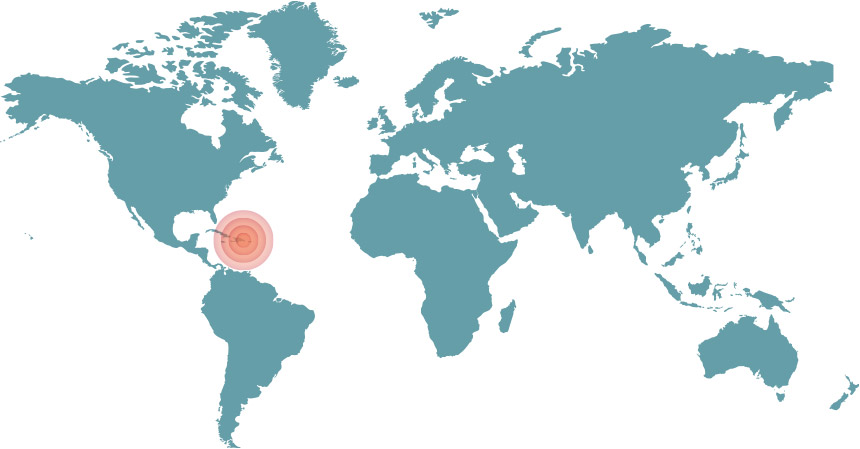Innovating with the private sector to fight climate change
Lesson learned: In expanding the current network of protected areas, it is important that new reserves do not take away human or economic resources that support existing protected areas. Innovative finance mechanisms, including investment from the private sector and payments for ecosystem services, can and should provide additional revenue.
Though they contribute little in the way of the carbon emissions, small island states are among the most vulnerable to sea level rise resulting from climate change. Some of these islands face levels of flooding that could render them uninhabitable by the end of the century. Already some low-lying islands have been submerged. CEPF grantees are assisting island nations as they implement one of the most significant actions they can take to have an impact in the fight against climate change, both locally and globally—conserving and restoring forests and natural ecosystems.
Caribbean Islands Biodiversity Hotspot

The Dominican Republic is one of the island nations at risk from sea level rise. In fact, a study by the World Bank found that Santo Domingo, the capital of the Dominican Republic, is one of the five cities in the world most at risk from climate change. By 2050, saltwater erosion and flooding could displace many of the country’s residents and infiltrate fresh groundwater.
Though averting such disaster will require global effort, Dominicans are taking local action to address climate change. Environmental group Consorcio Ambiental Dominicano (CAD) has developed a complex project with funding from CEPF and others to sequester carbon through a carbon credit program. CEPF had previously helped CAD in setting up the Dominican Republic’s first private nature reserve, the Reserva Privada el Zorzal. The majority of land within the reserve has been set aside as a permanent natural area, but a portion of it is used to plant cash crops like cacao and macadamia trees. Farmers on the reserve also plant native trees alongside the cacao and macadamia, and these provide an additional source of income to the local community involved in the reforestation. Reserva Privada el Zorzal partnered with Plan Vivo to sell carbon credits based on the trees’ rate of carbon storage.
These carbon credits are sold together with the organic cacao to chocolatiers in the United States and Canada. The participating companies are able to market their sustainable, single-source chocolate at premium prices, ensuring profit for them as well as for the farmers who grow the cacao, and the private reserve itself. A sustainable market for premium chocolate ensures the sustainability of the local economy that has sprung up around Reserva Privada el Zorzal.
Jesús Moreno, president of CAD, is optimistic about the entrepreneurial conservation project. “We turned a big, old cattle ranch into a private reserve where 60 percent of the land is conserved as forest and 40 percent is planted with organic cocoa and macadamia nut, which are sold to help finance reforestation activities inside and outside the reserve,” he said. “This project is good for the environment, it’s sustainable and it’s profitable.”
The reserve has increased protection over Bicknell’s thrush (Catharus bicknelli), a small bird listed on the IUCN Red List as Vulnerable, due in part to threats from deforestation of its wintering quarters in the Dominican Republic as well as to its breeding territory in the Northeastern United States and Canada.
Helados Bon, the largest ice cream franchise in the Dominican Republic, formerly owned by Moreno and his family, noticed both the need for conservation and the potential for profit in Reserva Privada el Zorzal. In addition to funding the project, the company created a special ice cream flavor that combines the organic cacao from the birds’ wintering location with maple from the trees of their northern breeding territory. This partnership between business and conservation is a pioneering vision of a world where sustainability and profit are not competing goals, but rather integrated outcomes of the green business economy.
Results
- Completed the carbon quantification, initial planting system, and sale of the Caribbean’s first forest carbon offset credits to chocolate companies in North America. It is estimated that the project will exceed US$750,000 in the sale of forest carbon credits over a 30-year period, ensuring long-term financing for the reserves.
- Developed a comprehensive habitat-monitoring protocol.
- Planted more than 32,000 native species trees with eight landowners participating in the Plan Vivo program in the Quita Espuela and Guaconejo ecological corridor.
- Created land-use plan, biological inventory, and management plan for Reserva Privada el Zorzal, which was adopted by the Ministerio de Medio Ambiente y Recursos Naturales (MIMARENA). These documents strengthened the environmental law and resolution that allow for the creation of private reserves.
- Created a mechanism for companies to offset their climate change impact, which combines the sale of cacao beans with Plan Vivo offset credits. This model is likely to be replicated at the national level.
Photo Credits
Reserva Privada el Zorzal, Dominican Republic. © Consorcio Ambiental Dominicano
Bicknell’s thrush (Catharus bicknelli). © Charles Kerchner




